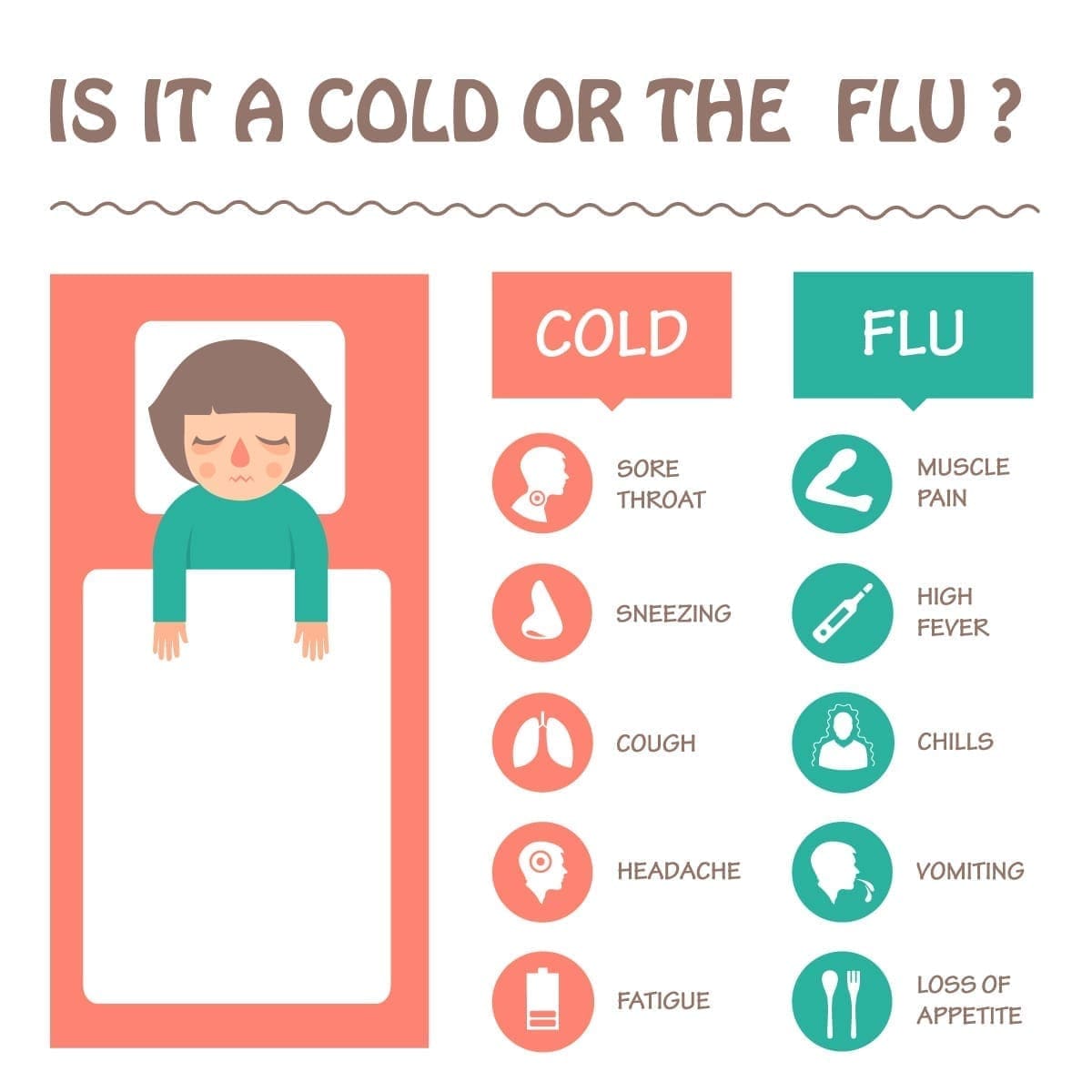
Flu is an infectious disease caused by influenza viruses that affects the respiratory tract. This disease can be mild or severe and can even be fatal in severe cases. Colds and the flu are often confused, but the flu is a much more serious condition.Flu viruses belong to the Orthomyxoviridae family and are divided into three main types: A, B and C. Flu A and B viruses are the main causes of influenza in humans. They cause seasonal flu outbreaks and epidemics. Flu A viruses are more prone to mutations and genetic diversity, allowing them to cause pandemics. This is called antigenic drift and shift.
Flu viruses are spread through droplets when an infected person coughs, sneezes or talks. Viruses can enter the body through the mouth, nose or eyes. Also, a person can get the flu when they touch an object that has flu viruses on it and then touch their face.
Once entering the body, influenza viruses begin to multiply in the cells of the respiratory tract. Viruses can cause inflammation and damage to cells in the airways, causing the typical flu symptoms. After infection, the body begins to produce antibodies against the virus, which help fight the infection and may provide some protection against the same flu virus in the future.
Due to its ability to mutate and spread rapidly between humans, influenza is a global public health problem. Every year, millions of people around the world get sick from the flu, and thousands die from complications of the flu, such as pneumonia. The flu can be especially dangerous for babies, the elderly, and people with weakened immune systems or those with chronic illnesses.
As a result, influenza prevention, including vaccination, and early treatment are critical aspects of health worldwide.
Flu viruses
Flu viruses belong to the Orthomyxoviridae family and are responsible for influenza infections. There are three main types of influenza viruses: A, B and C. Each of these types has a different structure and genetic material.
Flu A viruses are the most widely distributed and can cause seasonal flu outbreaks and pandemics. The genome of this virus species consists of eight different fragments that code for 11 proteins. This allows the virus to easily mutate and adapt to new hosts, a process called antigenic drift. In addition, influenza A viruses can exchange genetic material with other influenza A viruses, a process called antigenic shift, which allows the creation of new types of viruses.
Flu B viruses, compared to A viruses, are genetically stable and do not cause pandemics, but can cause epidemics. Their genome also consists of eight fragments, but they code for only nine proteins.
Flu C viruses are less common and cause milder symptoms. Their genome consists of seven fragments that code for nine proteins.
The structure of the flu virus contains two important proteins called hemagglutinin (H) and neuraminidase (N). These proteins allow the virus to enter and exit host cells. Different variants of the H and N proteins allow classification of subtypes of influenza A viruses, such as H1N1 or H3N2.
Flu viruses multiply by replication, when the virus invades a host cell and causes it to produce more viruses. After that, the viruses leave the cell and can infect other cells.
:max_bytes(150000):strip_icc()/a-day-by-day-look-at-h1n1-swine-flu-770511_color2-5b94a3ccc9e77c0082d41bd6.png)
What are the causes of influenza?
The cause of influenza is infection with influenza viruses. There are three main types of influenza viruses: A, B, and C, which can cause influenza infection in humans. Influenza A and B viruses usually cause seasonal flu outbreaks and epidemics, while influenza C viruses usually cause milder symptoms.
Influenza viruses are spread through droplets that an infected person releases when they cough, sneeze or talk. You can also get the flu by touching things that have flu viruses on them and then touching your face, especially your mouth, nose, or eyes. The viruses then enter the cells of the respiratory tract and begin to multiply.
In addition, there are some factors that can increase the risk of getting the flu. That includes:
Season: Influenza is most common in fall and winter, although specific seasonal trends may vary between regions and years.
Age: Children and older people are more vulnerable to flu infection and complications because their immune systems are weaker or not fully developed.
Conditions that weaken the immune system: People with chronic conditions such as asthma, diabetes, or heart disease, as well as people taking certain medications or undergoing cancer treatment, may be more vulnerable to flu infection.
Living environment: Nursing homes, schools, or the military can increase the chance of getting the flu.
Occupational activity: People who work in the healthcare field are more affected by the flu because they often come into contact with infected people.
Symptoms
The flu usually starts with a sudden onset of fever, usually 38.5 degrees or higher, along with other symptoms including headache, dry cough, sore throat, muscle or joint pain, fatigue and general weakness.
Fever may last 2-4 days, and general weakness and fatigue may last for several weeks. During the flu, people may lose their appetite. Other symptoms may include tremors, sweating, flushing of the skin, red eyes, and sensitivity to light.
The cough is usually dry and may continue after other symptoms have disappeared. The flu can also cause respiratory symptoms such as a runny nose, sneezing and hoarseness, but these are less common than flu viruses.
The flu can cause serious complications such as pneumonia, bronchitis, sinusitis and ear infections. These complications may include severe or prolonged fever, difficulty breathing or respiratory failure, chest pain, loss of consciousness or confusion, and severe or prolonged vomiting.
The flu can be especially dangerous for babies, the elderly, and people with weakened immune systems or those with chronic illnesses, as they tend to experience more severe symptoms and complications.
Possible complications
The flu can cause a variety of complications that can be serious and life-threatening. Complications are more common in people with reduced immunity, the elderly, young children, and individuals with certain chronic diseases. Here are some of the more common complications of the flu:
Pneumonia: This is the most serious and common complication of the flu. Pneumonia can be both viral and bacterial. Viral pneumonia can occur directly from the flu, while bacterial pneumonia can occur when bacteria infect lungs that are already damaged by the flu.
Bronchitis: The flu can cause bronchitis, which is an inflammation of the bronchi. This causes difficulty in breathing and can cause a prolonged cough.
Sinusitis and ear infections: These infections can occur when the flu causes inflammation and fluid buildup in the sinuses or ears.
Myocarditis and pericarditis: These are rarer but more serious complications that involve inflammation of the heart muscle (myocarditis) or heart membrane (pericarditis).
Encephalitis and Meningitis: These are very rare but very serious complications involving inflammation of the brain (encephalitis) or the membranes of the brain (meningitis).
Organ failure: Severe influenza can cause multiple organ failure, including lung, kidney, and heart failure.
Sepsis: This is a very serious complication that can occur when an infection spreads to the bloodstream and causes an inflammatory reaction throughout the body.

Flu or cold
Flu and cold are respiratory infections caused by different viruses. Although their symptoms may be similar, there are some important differences.
Cause: The flu is caused by influenza viruses (types A, B, and C), and the common cold is mainly caused by rhinoviruses, although there are many other viruses that can also cause the common cold.
Symptoms: Flu symptoms are usually more severe than cold symptoms. The flu often starts with a sudden high fever, headache, muscle aches, dry cough, sore throat and severe fatigue. Cold symptoms are usually mild and include runny nose, sneezing, hoarseness, sore throat and mild cough. Fever during colds is less common and usually low-grade.
Onset: Flu symptoms often appear suddenly, while cold symptoms usually develop gradually over several days.
Duration: The flu usually lasts longer than a cold. Flu symptoms can last for 1-2 weeks, while cold symptoms usually disappear within 1 week.
Complications: The flu can cause more serious complications, such as pneumonia, bronchitis, sinusitis, and ear infections. Complications of the common cold are less common, but can include sinusitis, ear infections, and asthma attacks.
Seasonality: The flu is more seasonal than the common cold, most common in the fall and winter, although common colds can occur at any time of the year.
Treatment: Both disorders are usually treated with symptomatic relief, such as pain relievers, antipyretics, and nasal drops. However, antiviral drugs can also be prescribed for the flu, which can reduce the severity and duration of the illness if taken within the first 48 hours of the onset of symptoms.
Is the flu preventable?
Prevention of influenza is especially important because of the potential complications caused by the disease. There are several important strategies to reduce the spread of the flu and prevent infection:
Flu vaccination: This is the most effective way to protect yourself from the flu. The vaccine works by stimulating the immune system to produce antibodies against flu viruses. If a person is subsequently exposed to these viruses, their immune system is already ready to neutralize them. It is important to note that a new vaccine should be obtained each year because influenza viruses are constantly mutating and the vaccine is updated each year based on the predicted dominant strains of influenza viruses.
Personal hygiene: Hand washing is an important aspect of flu prevention, as viruses can be transmitted through touched objects and surfaces. It is also recommended to avoid touching the eyes, nose and mouth with unwashed hands. During the flu, it's important to use tissues when you sneeze or cough and throw them away after use.
Social distancing: Influenza viruses are spread through airborne droplets when a sick person sneezes, coughs or talks. Social distancing can help reduce the risk of spreading this infection. This is especially important during flu season or flu epidemics.
Healthy lifestyle: A balanced diet, adequate sleep, regular physical activity and stress management can help maintain a strong immune system that is better prepared to fight infections, including the flu.
Antiviral medications: Some people who are especially vulnerable to flu infection, such as the elderly, people with chronic illnesses, or people with weakened immune systems, may be given antiviral medications to prevent the flu.

Before the flu season begins, the public should be educated about flu symptoms, prevention and treatment methods. This will help ensure that people are better prepared to protect themselves from the flu and reduce its spread. This is especially important for the elderly, pregnant women, young children, and individuals with chronic illnesses who are more prone to complications from the flu.
We can conclude that influenza is a serious public health problem that requires consistent prevention and effective treatment. Therefore, public health professionals and physicians need to continue education campaigns and encourage people to receive timely flu vaccinations to reduce the spread of influenza.
Sources of information:
Taubenberger JK, Morens DM. The pathology of influenza virus infections. Annu Rev Pathol. 2008;3:499-522. doi:10.1146/annurev.pathmechdis.3.121806.154316
Centers for Disease Control and Prevention (CDC). Flu Symptoms & Complications. https://www.cdc.gov/flu/symptoms/symptoms.htm Accessed on: September 2021.
Centers for Disease Control and Prevention (CDC). Diagnosing Flu. https://www.cdc.gov/flu/symptoms/testing.htm Accessed on: September 2021. ↩
Centers for Disease Control and Prevention (CDC). What You Should Know About Flu Antiviral Drugs. https://www.cdc.gov/flu/treatment/whatyoushould.htm Accessed on: September 2021.
World Health Organization (WHO). Influenza (Seasonal). https://www.who.int/news-room/fact-sheets/detail/influenza-(seasonal) Accessed on: September 2021.
# gripas
